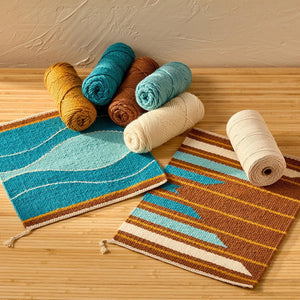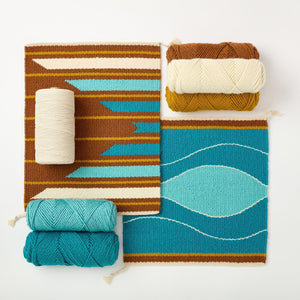Shopping Cart
*continental US addresses only


Learn rug weaving on your floor or tapestry loom with an introductory online course by expert weaver and teacher Rebecca Mezoff, and all the warp and weft yarn you need to complete two small projects.
You can use the colors she suggests, or use the dropdown menus below to select your own color palette.
Introduction to Rug Weaving covers weft-face tapestry techniques for rug weaving. You’ll learn the most important introductory concepts to create curves, eccentric curves, and angles, as well as the technical and finishing skills that make your projects shine. Rebecca will demonstrate these techniques on a tapestry and floor loom. This bundle includes yarn and video instruction for two small demonstration projects.
Most tapestry and floor looms will work for this course. Rebecca gives detailed advice in the course about what types of looms work best for more substantial rug weaving.
The kit includes all the warp and weft yarn you'll need to complete two small projects. You will also need a measuring tape or ruler, a tapestry needle, permanent marker, tapestry fork or beater, and a 6 or 12 dent reed if weaving on a floor loom.
This course uses Dwella, a rug-weight yarn, whereas Introduction to Tapestry weaving uses Array, a much finer yarn. This course is an excellent place to start learning tapestry techniques—the thicker yarn and wider sett is easier to manipulate than finer yarns, but the core techniques are the same. Rug-weight textiles require a slightly different approach to tapestry weaving and this course addresses that specifically. If you’d like to create functional table textiles or mug rugs, this course is ideal. You’ll also learn the skills needed to weave larger floor rugs on your own if you choose. However, if your main interest is weaving small-format wall tapestries, Introduction to Tapestry Weaving may be a better fit.
Rugs can be made using many different weaving techniques, including tapestry, where the warp is completely covered by the weft to make weft-faced images. A rug can be called a tapestry if it is woven with this structure. Whether we use a textile as something functional like a floor rug or a table textile, or we hang it on the wall as a decorative piece often has to do with the thickness of the yarn and the sett of the weave. In this course we’ll be making functional textiles for the home, but of course you could also hang them on a wall.
12" x 13" and 12" x 15"
This is a self paced course that utilizes pre-recorded videos. However, it contains interactive elements, and you'll be able to ask questions and interact with other folks taking the class.